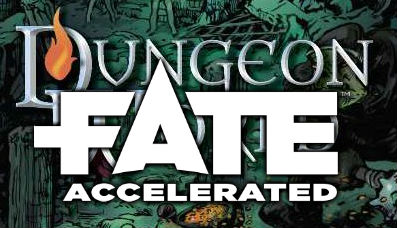
It’s a GenCon tradition in our group that we play a pretty half-baked, ill-prepared roleplaying game. This was the origin of such classic adventures as “Journey Through The Mud Mines” and “Take a Train to Go Turn Off a Radio.” This past GenCon was no exception, but we used a different system that I wanted to share.
Inspired by Rob Donoghue’s Blades of Fate writeup, I hacked together a mashup of Dungeon World and Fate Accelerated. This is mostly Rob’s writeup with a few tweaks. Here’s how it works.
This probably won’t make any sense if you’re not already familiar with Fate Accelerated. If you aren’t, good news – it’s a great $5 RPG that you should check out.
I love the core conceit of Dungeon World - failure is frequent and interesting. However, I wanted to graft that onto Fate’s narratively impactful aspects and a system that didn’t assume any particular setting. Dungeon World’s magic is in how well it evokes classic fantasy roleplaying. By contrast, we knew nothing about our setting until we sat down to talk about our characters and start playing.
I used the following ladder and corresponding numbers of dice:
This is slightly condensed from Rob’s version. Just like he’s struggled with articulating the difference between “Average” and “Mediocre,” I struggle with the difference between “Mediocre” and “Fair.” Thus, one tighter scale.
When you roll, you toss the corresponding number of Fudge dice and take the best result. That’s why the scale is so abbreviated - there’s no point when you are higher than Superb or worse than Terrible since the result is a foregone conclusion.
Die results are basically Dungeon World’s Defy Danger (that is, what Rob outlined in his article too).
I kept the six Approaches from Fate Accelerated as-is. The players were mostly new roleplayers and the six Approaches are a fantastic way to help new players not worry too much about the rules and instead narrate their intents.
With a condensed ladder I had to rethink what skills characters get at what levels. I kept the same rough distribution of skills from Fate Accelerated but mapped them to this adjusted ladder (1 at Great, 3 at Okay, 2 at Poor).
In this world, invoking an aspect moves you one step up or down the scale as desired. For positive invokes, this is relatively easy since you can add another die to the roll before or after without too much difficulty. However, this means that negative invokes only happen pre-roll. I like to run Fate with mostly pre-roll invokes anyway, but this runs against Fate orthodoxy.
Characters started with two fate points apiece. Since we were a pretty sizeable group, that was a plenty sizeable pool.
Otherwise it was mostly rules-as-written Fate Accelerated. We ditched stunts entirely but I’ve done that in basic FAE before without incident. We experimented briefly with stealing Dungeon World’s “only players roll” ethos but abandoned that midway through when we found the challenge lacking.
For dice rolls, we didn’t use the explicit system that Rob grafted in from Blades in the Dark. The spirit of those was still intact and is a useful way to counteract one of Fate Accelerated’s biggest problems, letting players lean too hard on a single approach. For example, we tried to make it clear that a Forceful solution was not going to be equally effective in all situations or equally safe either.
This played out pretty close to how I hoped, so I’m pretty happy with this hack. For players this was a incredibly fast system to learn. Spending aspect points just adds dice to a pool, and more dice is obviously better. Taking away the option to add +2, reroll, etc from FAE really helped.1
GMing this system is also a breeze - everything has the same fixed difficulty and if you don’t like that, you spend some fate points to make it harder for narratively interesting reasons. This was an end run around one of my only problems with Dungeon World’s fixed difficulties - new characters are too challenged by everything, experienced characters breeze through everything.
That said, I need to spend some time playing with AnyDice probabilities before I return this to the table. It was a little too easy most of the time - I saw fewer failures and blanks than I wanted to. Classic Dungeon World leans hard on the middle “7 to 9” results to generate narrative and we felt the absence of those complications in our game. It was mostly a story of things going to plan with the exception of our terribly unlucky warrior princess.
I may also take a look at adding some simple stunts back if I can figure out a way to do it that doesn’t require players to spend a bunch of time brainstorming how they mechanically work. That’s always been my challenge with stunts in Fate but that’s a topic for another time.
SP
This has an interesting unintended consequence - adding new dice to a roll isn’t guaranteed to make it better. If you failed, you have a 66% chance of improving it somehow. If you got mixed results, you have only a 33% chance of turning that into a success. It adds a little uncertainty into spending a Fate point. However, if you spend enough to go beyond Superb, you still just succeed regardless of roll. This allows players who really want to pass a particular check to creatively do so. ↩